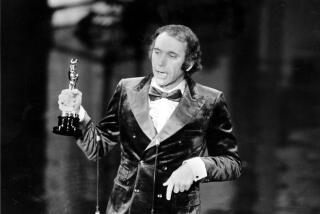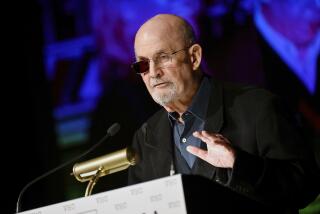Salman Rushdie bequeaths ‘Midnight’s Children’ to film
In the late 1970s, long before he penned “The Satanic Verses,” before he sparked a global uproar between Islamic fundamentalists and free-speech advocates and became a marked man, before he turned into a celebrity man of letters who dates models and starlets, Salman Rushdie was just the failed author of a sci-fi fantasy.
An obscure Indian expat living in England, he had only that first novel, “Grimus,” under his belt when he turned his attention to his homeland. While studying at Cambridge he had met E.M. Forster, the venerable British author of classics like “A Passage to India” and “A Room With a View,” and the elder novelist had encouraged him to write about the subcontinent. Rushdie greatly admired “Passage to India,” but he also determined to use it as a foil.
“The one thing I felt about Forster is that his writing, it’s fastidious, it’s precise, it’s cool. And if there’s one thing I think about India, is, it’s none of those things,” Rushdie recalled, sitting in the garden of a Beverly Hills hotel last month sipping mineral water.
“India is sort of hot and messy and vulgar and crowded and noisy,” he added. “And I thought if I was to try and write that book, how would I, instead of having this cool Forsterian language, have a ‘hot’ language? A language that represents noise and smell and sensuality and too-much-ness?”
The result was “Midnight’s Children,” a novel epic in scope and historical sweep that relates the mystical tale of two newborn boys who are switched by a nurse in a Bombay hospital at the stroke of midnight on Aug. 15, 1947 — the exact moment when India gained its independence from the British Raj. An instant critical and popular success in 1980, it won the Booker Prize and transformed its author into a diaspora-spanning interpreter for a nation of 1 billion.
It’s the kind of story that seemed ripe for adapting to the big screen. Yet that hadn’t happened, until now.
After several abortive attempts, “Midnight’s Children” finally has been made into a feature film by Indian-Canadian director Deepa Mehta, best known for her “Elements” trilogy of films, “Fire,” “Earth” and “Water.” Rushdie, who wrote the screenplay, also delivers the voice-over narration. Giles Nuttgens supplies the colorful cinematography and Nitin Sawhney the richly allusive musical score. The cast boasts a number of India’s most revered theater and film actors, including Seema Biswas and the one-named actor and pop idol Siddharth.
Rushdie’s attitude about the film’s delayed appearance? Better late than not at all.
“I actually had really given up the notion that there would be a film,” the 65-year old Rushdie said. “If I believed in such things as karma I would say that this was karma. Because the people that we put together on this occasion, it’s a group of much greater talent than we ever had before.”
“Midnight’s Children” centers on Saleem Sinai (Satya Bhabha), the illegitimate son of a poor woman, and Shiva (Siddharth), a wealthy and powerful family’s would-be scion, who cross paths and knock heads for decades after their identities are swapped. Their intertwined fates are mirrored by the spectacle of Hindu-majority India, cleaved in two to create Muslim-dominant Pakistan and East Pakistan (later Bangladesh).
Speaking by phone, Mehta recalled the book’s impact when she first read it in 1983 while living in Delhi.
“It’s the first time I had read a novel where I felt the English language had been chutney-fied or actually had been reworked with Hindi in such a way that it made it very personal to Indians,” she said.
Like the book, the film begins in 1917 and ends in the late ‘70s, leap-frogging from Kashmir and Agra to Rawalpindi, Karachi, Bombay, Dacca and New Delhi. (The movie actually was shot in Sri Lanka, Mehta said, because Bombay and Delhi now look too modern.) It encompasses not only Indian independence and partition, but the various India-Pakistan wars, the Bangladesh war and the controversial mid-1970s “state of emergency” presided over by then-Prime Minister Indira Gandhi.
It’s the kind of monumental saga that, in previous generations, would have been served up on a Sterling platter by David Lean or Merchant-Ivory, or in a ponderous miniseries. Instead, it’s been necessarily condensed into a screen treatment that critic Peter Bradshaw praised in Britain’s the Guardian newspaper as a “watchable, robust piece of storytelling,” albeit “rather soupy” and soap-opera-ish.
Ali Behdad, a UCLA comparative literature professor, says “Midnight’s Children” helped redefine post-colonial literature by combining a cosmopolitan, postmodern storytelling style with fantastic Bollywood-like imagery and imaginative political allegory.
“It really made the post-colonial writer a much more sophisticated writer, in the same sort of tradition of [Gabriel] García Márquez, than other Third World writers that we know,” Behdad said.
Storytelling is practically a birthright for Rushdie, who as a child was surrounded by his family’s gifted narrators. His parents, aunts and uncles would regale him from memory with the Arabian Nights tales, as well as subcontinental classics like the Kashmiri folk-tale collection “Kathasaritsagara, or Ocean of the Streams of Story,” and the “Pachatantra” animal fables.
He also devoured Norse, Greek and other Western mythologies, threads of which have cropped up in works such as his 1999 novel “The Ground Beneath Her Feet,” based on the myth of Orpheus and Eurydice. The fateful infant-swap in “Midnight’s Children” evokes a slew of myths about changelings and separated-at-birth siblings. And Saleem’s main physical characteristic is a prodigious nose that suggestively recalls the elephant deity Ganesh.
“These ancient stories have a great deal to tell us,” Rushdie said, “partly because meaning in mythology is so compressed. They allow you to dive in and unpack them.”
The author said he “used the structure of my family, but not the characters,” in crafting “Midnight’s Children.” Like Saleem, he had a relative who was a general in the Pakistani army and a grandfather who was a doctor. And like his protagonist, Rushdie grew up in Bombay — before being sent to England for boarding school.
He later attended King’s College, Cambridge. It was there that Rushdie met Forster, who was a fellow of the college and who told him to write about India (Forster’s “Passage to India,” “Howard’s End” and “Room With a View” were adapted into Oscar-winning films after his death in 1970).
“He was a very unassuming, modest man, very open to students, and gentle,” Rushdie said. “He said, ‘Yes, of course you must do that, that’s exactly what should happen, it must be Indian writers who write about India.’”
For a while after graduating, Rushdie earned a living writing ad copy, which connected him with a number of up-and-coming British film directors who were then shooting commercials. “So I made a Clairol Loving Care commercial with Nicolas Roeg. Alan Parker, Hugh Hudson, Ridley Scott, Tony Scott, all these people some of the time making advertising commercials.”
But while living in London, Rushdie said, he worried about “becoming detached from my place of origin and culture and heritage.” After “Grimus” flopped, it took a trip back to Mother India with his first wife, Clarissa Luard, to supply him with the theme and details of his breakthrough book.
Three decades, three spouses and a dozen books later, Rushdie now is a gray eminence, a longtime New Yorker, a frequent subject of tabloid fodder and a man who’s clearly glad not to be in the cross-hairs of East-West conflict. He has moved beyond the divided self that he dramatizes in “Midnight’s Children” and has “come to terms with the life that I have.”
“I hope,” he said, “not to have an interesting life from now on.”
PHOTOS AND MORE
Roger Ebert: Career in pictures
ENVELOPE: The latest awards buzz
PHOTOS: Greatest box office flops
More to Read
Only good movies
Get the Indie Focus newsletter, Mark Olsen's weekly guide to the world of cinema.
You may occasionally receive promotional content from the Los Angeles Times.











